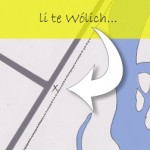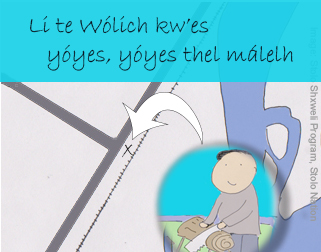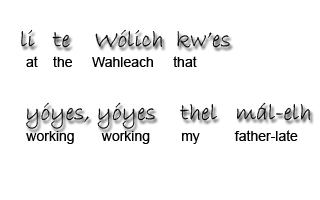Li te Wólich kw’es yóyes, yóyes thel málelh means ‘My late father was working at Wahleach’.
Pronunciation
Sounds like ‘lee te WALL-each kwuss YEYE-us thill MAL-ith’, except that:
- The k in kw’es is ‘popped’ (‘ejective’), which you make by combining the k with a catch in the throat (‘glottal stop‘).
- Instead of a th at the end of the last word you say the Halq’eméylem hissy-l (lh). This is like a regular l, but hissy, and with no vibration in the throat.
Audio: Elizabeth Herrling
Structure
The phrase consists of these elements:
- li – in, at, on (speakers also use li in a number of other ways)
- te – the (unlike in English, Halq’eméylem often requires the equivalent of English the before a name)
- Wólich – Wahleach (a place name)

- kw’es – that
- yóyes – working

- thel – my (Many speakers would say tel before males, but speakers vary.)
- mál – father

- thel malelh – my late father

Note: there is no equivalent to ‘was’ (or any form of ‘to be’) in the language. The tense here is just understood from context.
Note also: Halq’eméylem word order is quite different. Here, ‘at Wahleach‘ comes first in the sentence, so literally you say ‘At Wahleach that working my late father’.



No comments yet.